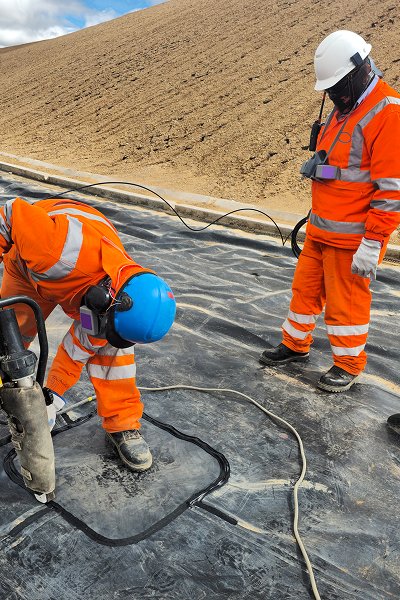Geogrid is a high-strength geosynthetic material used to reinforce soil and improve ground stability. It provides excellent tensile strength, reduces deformation, and enhances load-bearing capacity. Widely applied in road construction, retaining walls, slopes, and railways, geogrids ensure long-term durability and cost-effective soil reinforcement solutions.
Uniaxial geogrid is made of high-strength polymer materials, designed for soil reinforcement and slope retaining walls. It provides excellent tensile strength in one direction, improving stability and load-bearing capacity in road and embankment projects.
Biaxial geogrid features balanced tensile strength in both longitudinal and transverse directions. It effectively enhances soil stability, distributes loads evenly, and is ideal for roads, railways, and foundation reinforcement.
Fiberglass geogrid is made from alkali-resistant glass fiber, offering high tensile strength and low elongation. It prevents pavement cracking, extends road life, and is widely used in asphalt reinforcement and road repair.
Polyester geogrid, woven from high-strength PET yarns, provides outstanding creep resistance and durability. Suitable for long-term soil reinforcement, retaining walls, and slope protection in civil engineering projects.
Triaxial geogrid features a unique triangular structure that delivers superior load distribution and shear resistance. It improves pavement stability and performance under heavy traffic conditions, ideal for highways and airports.
-
Geotube
-
Geogrid
-
Nonwoven Geotextile
-
Woven Geotexitle
-
Nonwoven Geo Bag
-
Geosynthetics Clay Liner
-
Anti Grass Cloth
-
Plastic Grass Grid
-
Drainage Board
-
Adjustable Pedestal
-
Composite Geomembrane
-
Tarpaulin
-
Drainage Cell
-
Road Crack Sealing Tape
-
Geographic Grid
-
Geomembrane welding machine
-
Three Dimensional Geomat
-
Composite Geonet
-
Asphalt cold patch
-
HDPE Geocell
-
Geomembrane
-
 Composite fiberglass geogrid
Composite fiberglass geogrid
Composite Fiberglass Geogrid is a composite georeinforced material that combines high-strength fiberglass mesh with geotextile or asphalt reinforcement materials (such as geomembranes, nonwoven fabrics). It has excellent tensile strength, high temperature resistance, fatigue resistance and bonding properties, and is widely used in structural reinforcement and life extension treatment in infrastructure projects such as roads, airport runways, embankments and railways.
-
 Composite Geogrid
Composite Geogrid
Composite geogrid is a new type of high-strength geosynthetics, usually composed of glass fiber, polyester fiber or plastic geogrid and non-woven fabrics, geotextiles, etc. This product combines the high tensile strength of geogrid with the isolation, filtration, drainage and other functions of geotextiles, and is widely used in engineering fields such as soft foundation reinforcement, roadbed reinforcement, slope protection, etc.
-
 Green PP Biaxial Geogrid
Green PP Biaxial Geogrid
Biaxial Green Geogrid is a geosynthetic material made of polypropylene (PP) or high-density polyethylene (HDPE) as the main raw material, which is formed by extrusion, punching, and longitudinal and transverse stretching. Its structure is a regular mesh, with balanced tensile strength in both longitudinal and transverse directions, and uses environmentally friendly green pigments.
-
 PP Biaxial Geogrid
PP Biaxial Geogrid
PP bidirectional geogrid is a high-strength geosynthetic material made of polypropylene (PP) through extrusion, punching, heating, and longitudinal and transverse stretching. Its main function is to improve the bearing capacity of soil and enhance the stability of roadbed. It is widely used in various infrastructure construction.
-
 Fiberglass Geogrid
Fiberglass Geogrid
Fiberglass geogrid is a reinforcing material made of glass fiber through weaving, coating and other processes. It has the characteristics of high strength, corrosion resistance, and aging resistance, and is widely used in foundation reinforcement, road reinforcement, slope protection and other fields in civil engineering.
-
 Uniaxial Geogrid
Uniaxial Geogrid
Uniaxial geogrid is a geosynthetic material made of high molecular polymer materials (such as HDPE or PP) through a stretching process. It has the characteristics of high strength, corrosion resistance, and tensile resistance. It is mainly used to reinforce soil, improve foundation bearing capacity, and extend the service life of the project.
-
 Polyester Geogrid | High Strength Geogrid for Soil Reinforcement
Polyester Geogrid | High Strength Geogrid for Soil Reinforcement
High tensile strength polyester geogrid for soil stabilization, retaining walls, and road construction. Factory price and customized specs available.
-
 Polyester Geogrid
Polyester Geogrid
Polyester geogrid is a mesh geotechnical material made of polyester (PET) as the main raw material through warp knitting process. It has excellent properties such as high strength, low elongation, corrosion resistance and aging resistance, and is widely used in the field of civil engineering.
-
 Triaxial Geogrid
Triaxial Geogrid
Triaxial geogrid is a new type of high-strength geosynthetics. Compared with traditional uniaxial or biaxial geogrids, triaxial geogrid adopts a three-way mesh structure, which can disperse the load more evenly and improve soil stability. This product is mainly used to enhance the bearing capacity of soft foundation, prevent roadbed settlement, and improve engineering durability. It is widely used in highways, railways, ports, water conservancy and other fields.
-
 Biaxial Plastic Geogrid
Biaxial Plastic Geogrid
PP(Polypropylene) biaxial geogrid is manufactured from PP, it is produced through the process of extruding, punching, heating,longitudinal and transverse stretching.
-
 Steel-plastic Geogrid
Steel-plastic Geogrid
Steel-plastic geogrid is a composite geosynthetic material with high-strength steel wire (or steel belt) as reinforcement material and a polyethylene (PE) or polypropylene (PP) protective layer wrapped on the outside. It combines the high strength of steel and the corrosion resistance of plastic, and is widely used in projects such as roadbed reinforcement, slope protection, retaining walls, etc., especially suitable for reinforcement needs under high loads and complex geological conditions.













